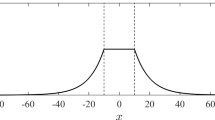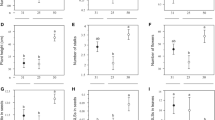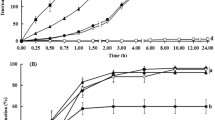Abstract
In plants where reproduction is fatal, seed-feeding insects may have a major impact on the evolutionarily stable reproductive strategy by altering fecundity schedules in a size-dependent manner. We explored this in Carduus nutans, a facultative biennial native to Europe, using two years of data from the South of France. An integral projection model based on detailed statistical models of the demography of Carduus nutans and characteristics of herbivore attack showed that seed predators select for smaller flowering size. An elasticity analysis showed that changes in the slope relating seed herbivore attack rates to plant total receptacle area had a large effect on lifetime reproductive success relative to most other plant demographic rates. Together, these two results indicate that in the absence of seed predators, as is the case in the exotic range of this invasive species, flowering size could evolve to be larger. Further analysis also showed that subsequent introduction of different species of seed-feeders as biocontrol agents could lead to different evolutionary outcomes dependent on the ecological characteristics of the seed-feeders, allowing the direction and magnitude of evolutionary change in flowering size to be predicted based on what seed predators have been introduced where and when. Such data would allow us to distinguish between the effect of seed predators and other hypotheses for size increase in the invasive habitat.






Similar content being viewed by others
References
Blossey B, Nötzold R (1995) Evolution of increased competitive ability in invasive nonindigenous plants: a hypothesis. J Ecol 83:887–889. doi:10.2307/2261425
Caswell H (2001) Matrix population models: construction, analysis and interpretation, 2nd edn. Sinauer Associates Inc., Sunderland
Childs DZ, Rees M, Rose KE et al (2003) Evolution of complex flowering strategies: an age and size structured integral projection model approach. Proc R Soc Lond B Biol Sci 270:1829–1838. doi:10.1098/rspb.2003.2399
Easterling MR, Ellner SP, Dixon PM (2000) Size-specific sensitivity: applying a new structured population model. Ecology 81:694–708
Ellner SP, Rees M (2006) Integral projection models for species with complex demography. Am Nat 167:410–428. doi:10.1086/499438
James TK, Rahman A, Wardle DA et al (1998) Survival of nodding thistle (Carduus nutans) seed buried at different depths in four soils. New Zeal Weed Pest Control Conf Proc 51:33–37
Jongejans E, Sheppard AW, Shea K (2006) What controls the population dynamics of the invasive thistle Carduus nutans in its native range? J Appl Ecol 43:877–886. doi:10.1111/j.1365-2664.2006.01228.x
Julien MH, Griffiths MW (1998) Biological control of weeds: a world catalogue of agents and their target weeds, 4th edn. CABI Publishing, UK
Keane RM, Crawley MJ (2002) Exotic plant invasions and the enemy release hypothesis. Trends Ecol Evol 17:164–169. doi:10.1016/S0169-5347(02)02499-0
Klinkhamer PGL, Kubo T, Iwasa Y (1997) Herbivores and the evolution of the semelparous perennial life history of plants. J Evol Biol 10:529–550. doi:10.1007/s000360050040
Lee JM, Hamrick JL (1983) Demography of two natural populations of musk thistle (Carduus nutans). J Ecol 71:923–936. doi:10.2307/2259602
Louda SM, Potvin MA (1995) Effect of inflorescence-feeding insects on the demography and lifetime fitness of a native plant. Ecology 76:229–245. doi:10.2307/1940645
Metcalf JC, Rose K, Rees M (2003) Evolutionary demography of monocarpic perennials. Trends Ecol Evol 18:471–480. doi:10.1016/S0169-5347(03)00162-9
Muller-Scharer H, Schaffner U, Steinger T (2004) Evolution in invasive plants: implications for biological control. Trends Ecol Evol 19:417–422. doi:10.1016/j.tree.2004.05.010
Mylius SD, Diekmann O (1995) On evolutionarily stable life-histories, optimization and the need to be specific about density-dependence. Oikos 74:218–224. doi:10.2307/3545651
Popay AI, Medd RW (1995) Carduus nutans L. ssp. nutans. In: Groves RH, Shepherd RCH, Richardson RG (eds) The biology of Australian weeds. RG & FJ Richardson, Frankston, Victoria, Australia, pp 29–49
Popay AI, Thompson A, Bell DD (1987) Germination and emergence of nodding thistle (Carduus nutans L.). In: Lemerle D, Leys AR (eds) Proceedings of the 8th Australian weed conference, weed society of New South Wales, Sydney, New South Wales, Australia, pp 175–178
R Development Core Team (2005) R: a language and environment for statistical computing. R foundation for statistical computing. Vienna, Austria. http://www.R-project.org
Rees M, Rose KE (2002) Evolution of flowering strategies in Oenothera glazioviana: an integral projection model approach. Proc R Soc Lond B Biol Sci 269:1509–1515. doi:10.1098/rspb.2002.2037
Rees M, Childs DZ, Metcalf JC, Rose KE et al (2006) Seed dormancy and delayed flowering in monocarpic plants: selective interactions in a stochastic environment. Am Nat 168:E53–E71. doi:10.1086/505762
Rose KE, Rees M, Grubb PJ (2002) Evolution in the real world: stochastic variation and the determinants of fitness in Carlina vulgaris. Evolution Int J Org Evolution 56:1416–1430
Rose KE, Louda SM, Rees M (2005) Demographic and evolutionary impacts of native and invasive insect herbivores: a case study with Platte thistle, Cirsium canescens. Ecology 86:453–465. doi:10.1890/03-0697
Shea K, Kelly D (1998) Estimating biocontrol agent impact with matrix models: Carduus nutans in New Zealand. Ecol Appl 8:824–832. doi:10.1890/1051-0761(1998)008[0824:EBAIWM]2.0.CO;2
Shea K, Kelly D, Sheppard AW, Woodburn TL (2005) Context dependent biological control of an invasive thistle. Ecology 86:3174–3181. doi:10.1890/05-0195
Sheppard AW (1996) The Cardueae: weeds and the impact of natural enemies for biological control. In: Hind DJN (ed) Proceedings of the international Compositae conference, Kew, vol 2. Royal Botanic Gardens, Kew, pp 291–306
Sheppard AW, Cullen JM, Aeschlimann JP et al (1988) The Importance of insect herbivores relative to other limiting factors on weed population dynamics: a case study of Carduus nutans. In: Delfosse ES (ed) Proceedings of the VII international symposium on the biological control of weeds, MAF, Rome Italy, pp 211–219
Sheppard AW, Cullen JM, Aeschlimann JP (1994) Predispersal seed predation on Carduus nutans (Asteraceae) in Southern Europe. Acta Oecol 15:529–541
Wesselingh RA, de Jong TJ (1995) Bidirectional selection on threshold size for flowering in Cynoglossum officinale (Hounds tongue). Heredity 74:415–424. doi:10.1038/hdy.1995.59
Wesselingh RA, Klinkhamer PGL (1996) Threshold size for vernalization in Senecio jacobaea: genetic variation and response to artificial selection. Funct Ecol 10:281–288. doi:10.2307/2389854
Willis JA, Memmott J, Forrester RI (2000) Is there evidence for post-invasion evolution of increased size among invasive plant species? Ecol Lett 3:275–283. doi:10.1046/j.1461-0248.2000.00149.x
Woodburn TL, Sheppard AW (1996) The demography of Carduus nutans as a native and an alien weed. Plant Prot Q 11:236–238
Acknowledgements
We thank Mike Gillman and Mick Crawley who commented on an earlier draft of the manuscript. We would like to thank J.M Cullen and J.-P Aeschlimann for research on the Carduus system in France and Australian Wool Innovations and the Australian Government for supporting this research.
Author information
Authors and Affiliations
Corresponding author
Rights and permissions
About this article
Cite this article
Metcalf, C.J.E., Rees, M., Buckley, Y.M. et al. Seed predators and the evolutionarily stable flowering strategy in the invasive plant, Carduus nutans . Evol Ecol 23, 893–906 (2009). https://doi.org/10.1007/s10682-008-9279-8
Received:
Accepted:
Published:
Issue Date:
DOI: https://doi.org/10.1007/s10682-008-9279-8




